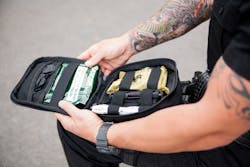Officer John Bell waited out the nasty weather holed up at a local Haltom City business. Simultaneously, Haltom City Police Department set up nearby on a drug buy. The [officers] that day included Lieutenant Terry Stayer, a 20-year veteran. The dealer showed but eluded the officers who went in pursuit. The suspect soon crashed, wrecking only 100 yards or so from the business occupied by Bell, unbeknownst to him. Haltom set up a perimeter but was unable to locate the suspect.
Eventually units cleared. But Stayer continued searching the area, now on foot, in the rain. Heading back towards the crashed car, Stayer met an inquisitive Bell. She explained the situation but was soon called away when a citizen reported seeing somebody jump a fence nearby. While searching, she heard several loud pops, but it didn’t sound like gunfire. She stopped and asked another officer if he had heard the noise, too and what he thought. He agreed it didn’t sound like gunfire. Both officers cleared the area.
Now Stayer headed back towards the business. That’s when she was told Fort Worth was responding to the area for a report of shots fired and put two and two together. Her worst fears were confirmed—Bell had been shot three times. The next thing she did was pull out her Officer Survival Solutions (OSS) Trauma Plate Pouch, an Individual First Aid Kit (IFAK) she had been issued that morning.
“He was shot in the leg—up high in the groin area, above his right eye and his left middle finger had been shot off,” Stayer recalls. “That’s when I got my pack out of the front of my vest. I utilized the contents even though I [didn’t use] some of the stuff for its intended purpose, like the pressure bandage. I used that on his facial wound because the round went in above his eye and exited in his cheek. I used that to try to apply pressure to those areas.” Stayer also used the hemostatic gauze. She cut Bell’s pants open enough to get to the wound in the groin area. “The gun that was used to shoot him was a .380, a smaller caliber, so I wasn’t able to get the gauze all the way down into the wound,” she says. “I got it in as best I could. I applied pressure and held what I had until paramedics got there.”
Stayer helped save Bell’s life not only because she utilized her IFAK, but because she was the one who requested they be purchased in the first place. “You get any type of major artery injury, you’re just not likely to make it waiting on medics to get there,” she says about wanting the kits. “I started looking for something that I could get for my officers that they could have with them to increase the odds of them surviving or being able to help somebody survive a major injury like that. I came across those packs with OSS. I decided to get enough for every single sworn officer we had.”
Stayer’s story has echoed dozens of others where an officer survived because an IFAK was issued. Many original kits, unfortunately, were inappropriate for patrol officers. They contained regular first aid items and were too large to carry on an officer’s person. Several companies noticed and designed appropriate IFAKs centered on three “rights”: right product, right packaging, and right price.
Right product
OSS, maker of the Trauma Plate Pouch used to save Bell’s life, is a company run by those who have “been there, done that.” They state their kits include the most advanced medical gear available, but are designed to be used by an average patrol officer with no medical experience. Marc Barry, OSS’s President/COO was inspired to create the kit after his partner bled to death. “At the time there was no such thing as a trauma kit for cops,” Barry says. He also talked about the kit 95 percent of departments in the U.S. had in their trunks: “There was a black bag that had a little red plastic lock on it. It was printed really nice and it said, ‘Trauma/Shooting Kit.’ The departments never trained on the items. They never opened it to see what was in it. They just took it at face value that this was a shooting kit. Well, when you opened it you had gauze, tape, shears, aspirin and Band-Aids. Nothing that would save your life if you’ve been shot. Absolutely nothing.”
After 21 years with Las Vegas Metropolitan Police Department, Barry retired and headed overseas as a contractor. “Some of the corpsman who were assigned to us were treating these gunshot wounds like they were scratches,” Barry says. “My first thought was, ‘Why don’t we have this as cops?’ A gunshot wound is a gunshot wound.”
Barry sat down and created the patrol pocket pack which has a tourniquet, hemostatic gauze, pressure bandage, gloves and instruction card. The first three, he says, are the most critical items for any penetrating trauma injury. Since beginning his company in 2009, his products, including the Patrol Pocket Pack, Trauma Plate Pack and Patrol Pack, are available in more than 3,000 police departments.
Another company, Tactical Medical Solutions (TacMed) also has roots in law enforcement and agrees IFAKs for patrol officers need to have essential components. CEO Ross Johnson started TacMed in 2003 after creating the SOF Tactical Tourniquet while serving on active duty.
“He modified and perfected his design throughout usage during his deployment in Afghanistan,” says Jon Carlson, Sales and Training. “He really perfected the first SOF T tourniquet that we ever did.” TacMed believes this is the most important component of an IFAK— the one product that can make a difference in a short amount of time between potentially living and potentially dying. “It’s no secret that large arterial bleeds can cause a person to bleed out and lose consciousness in two minutes or thereabouts,” he says.
Currently, 75 percent of the top 10 largest departments use TacMed’s products, as well as a large number of the more common 65-man and less departments. In 2015, TacMed was chosen as the primary vendor of IFAKs for the Department of Homeland Security.
“We try to keep our kit up-to-date with advanced versions of what’s coming out,” says OSS’ Barry. “A lot of things are coming out that are just marketing ploys. Stuff that will work under certain situations. An ER doc treating a gunshot wound in the ER is much different medicine and equipment than a patrol cop pinned down behind his car bleeding to death. We’re not making kits for ER docs. We’re making kits for cops who need help instantly.”
Right packaging
The right products won’t help save a life if the packaging is too bulky for the officer to carry. Barry says they focus on patrol, as SWAT and specialized units, hostage rescue, etc. generally have the gear and training, but they aren’t the ones getting shot. Even though the Pocket Packs were successful, OSS was approached by officers saying they needed something different. “A lot of the female officers were coming to me saying these won’t fit,” says Barry. Their shirts had been tailored so the pack was too big for the pocket size. In response, he developed a smaller, thinner kit that fits behind the trauma plate in their body armor. “It’s basically a flat pack under ½-inch thick,” he says. “It’s really thin and pliable.” TacMed also put a lot of thought into packaging their IFAKs.
“There’s a number of different uniform styles out there,” says Carlson. “We designed a bunch of different styles of IFAKs to facilitate that. We quickly learned there isn’t a one-size-fits-all for law enforcement. We try to make as many possibilities so people can best choose the IFAK that fits them.” IFAKS are designed to fit in a shirt or cargo pocket, on a belt or behind a trauma plate. Designing them like this ensures officers will carry them. It doesn’t really help the officer if something happens and the kit is in the car. “To find ways to have it on their person and not have it impede their uniform function, appearance and comfort level is a challenge that we try to meet in our products.” The OSS Pocket Pack Series is even designed to be rugged enough to be skipped, thrown or kicked to a downed officer in a hot zone. “The component part is generally easy,” Carlson says about package design. “It’s the personal preference part that is difficult. That’s where we put a lot of our effort.”
Right price
Even more important than finding a solution to bulky design, companies offering IFAKs had to consider cost. Both OSS and TacMed keep their prices low. “When you need the kit, you need it now,” says Barry. “It’s a lifesaving event. Knowing that, we’re just trying to give the officers what they need to survive. If you look at pricing, we may make like $3 or $6 on a kit that other companies are charging 200 to 300 times more for, but I know what a patrol officer makes. If you put a $300 price tag on a kit, for a patrol officer, he’s not going to buy it because he can’t afford it. It’s not going to save a life sitting on a shelf.” Carlson agrees. “We’re the manufacturer,” he says. “When you talk about law enforcement, we try to pass on as much of the savings as possible. Not just as a department purchase, but as an individual purchase as well because we were there.”
When Stayer petitioned Haltom City to buy the IFAKs that eventually saved Officer Bell’s life, she was also thinking cost … but in a different way. “The day I purchased them it was money well spent. As far as I’m concerned every officer, not only in the United States but across the world, should have one. I think at the time the packs were $44. How much would you pay to save a loved one’s life? All my guys are important to me and their families are important and $44 is nothing when it comes to that.”
Two days prior to his interview, Barry was advised by Oakland PD that they have used OSS’ kits 15 times in the last 30 days. Four of those were confirmed saves where the ER doctor stated the use of the kit saved the person’s life. “We’re up to 26 police officers that were saved in the last four years,” Barry says. “We’re up to about 103 citizens.” TacMed has numerous saves as well.
It’s been three years since Stayer saved Bell’s life with her IFAK. She continues to think about the importance of the kits and wishes every law enforcement agency in the country issued them to their officers. She even considered, at one point, creating a non-profit organization where the monies raised would be used to purchase kits which would be distributed to agencies that couldn’t afford to get them for their officers. “I think it’s a wonderful idea,” she says. “I hope somebody would do it if not me.”
Stayer dreams of putting an IFAK with the right products, right packaging and right price in the hands of every sworn officer on the street. Just think of the lives that could be saved.
Michelle Perin has been a freelance writer since 2000. In December 2010 she earned her Master’s Degree in Criminology and Criminal Justice from Indiana State University.



